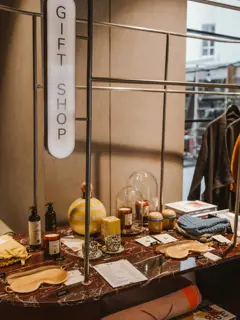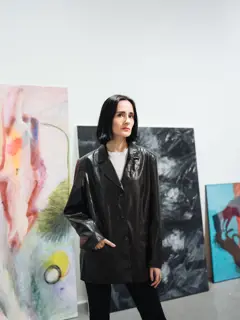"I get inspiration for painting as if I’d like to eat what I see. The physicality of the picture is important, as is the fact that the outcome of my work is an object" says Magdalena Karpińska, the heroine of the first episode of "Behind the Art" video, produced by PURO.

Nature and landscapes are a constant feature of your work. I wonder what your personal relationship to nature is? Do you have a special bond?
I see nature as having two sides. The first is soothing, conjuring associations with permanence, repetition, and the natural cycles. We are looking at trees that people living here saw many years before us. Everyone needs to escape to the greenery from the urban noise and commotion. On the other hand, nature can be terrifying. Sometimes it makes us feel small and defenseless. My interest sits in that ambivalence—between the need and the yearning, and the fear and the disquiet.
My first thought was Timothy Morton’s book Dark Ecology, in which he writes about the brutal, awful, revolting side of nature we often glaze over in our idealized, idyllic vision. Your pictures can also be unsettling.
Right. I often meet people who think that, since I paint nature, I must live in the country, lead a life in harmony with the environment, and that I’m into botany. I love growing plants, but I’m no expert. I’m more like a frightened observer, yearning and conscious of the dangers. I remember a childhood story from a warm vacation period. That was the first time I saw a huge, red moon. I started panicking that it was the end of the world. The grown-ups had to calm me down. It’s just an anecdote, but it shows my relationship with nature, which is inconceivable and foreign to me. And right now, we can see that even more clearly, observing the results of the climate crisis.
Is that why your pictures often have nocturnes? Are they meant to suggest the horror of the situation?
I don’t see nocturnes as sinister. Evenings are my favorite part of the day. I don’t like the scramble of the morning, the harsh light. I like it when everything softens, then I can paint for hours.
Plants are the main protagonists in your paintings. There’s no classical staffage in your landscapes, but there are many human features, like hands, mouths, eyes. Why?
People are always there in my work. I always introduce a personal perspective, as an observer. It is never a pure depiction of nature, it is always filtered through my emotions. When people appear in a picture, they are always part of an ecosystem. Parts of human bodies blend with fragments of plants, because I perceive them as a whole. In my work, the leaves have fingers, mouths, tongues, a tree takes the shape of a face. That is why I paint a mouth swallowing the moon like a pill. I integrate body and landscape.
Tell us about the narrative and symbolic motifs in your work, for instance in Leda with Swan.
The very fact that art exists is encouraging to me. I am fascinated by the eternal need to create. I am moved that the human species, in many regards destructive, has this abstract need. So I come back to various themes, motifs, and attitudes that interest me. Like Leda and the swan, which strikes me as an absurd story from Greek mythology; it is a popular motif in Renaissance paintings, for instance, and yet so peculiar, and surprisingly, socially and institutionally acceptable as the amorous act of a woman.
You also often use the Manus dei, the hand of God.
Yes, in the works for the PURO collection, for instance. That is a motif known in part from the mosaics in Ravenna and other historical works where the hand of God appears to point the way, showing a specific solution to a human problem. “Go there,” “read this”— simple solutions suggested by God. I love those kinds of absurd tropes in culture.

Does your art use humor, absurdity, or visual puzzles?
Not directly, but when you take a close look at the picture from the PURO collection, for instance, you’ll mainly see undergrowth and a hand pointing the way. That strikes me as a humorous motif, but I don’t expect anyone to look at the picture and laugh.
Your art is quite sensual, but it also relays your perception of the world.
I get inspiration for painting as if I’d like to eat what I see. The physicality of the picture is important, as is the fact that the outcome of my work is an object. I shape a concrete material, a substance, which arises from a fluid process and concept. Paradoxically, the more technology there is all around, and the more I think about artificial intelligence, the more I want to be grounded in reality. I am fascinated by painting and its history. It is a visual and sensory history of humanity. Through this language of the senses I speak of bodily inspirations.
You paint hands, mouths, and eyes, which are sensory receptors!
Yes, that’s how I stress a desire to experience the world. Looking, licking, touching.
What is your creative process? Do you plan your compositions, or work more expressively?
I’m always collecting inspiration, fragments of pictures. I write them down in words, take pictures, or make sketches. I work on the concepts for a long time. I sketch quick outlines in pencil, and sometimes, when I’m planning large pictures I make more precise drawings with color. Just as important to me, however, is the fresh, intuitive energy of the picture, which crystallizes in the course of the work. I like it when the pictures ripens. I often rely on intuition. Painting is a process with various stages of pleasure. There’s the inspiration phase, the idea, the flash that brings hope and excitement. Then comes the hard part, because the ideal concept materializes in the course of painting. I look for ways of reaching the goal, which can be frustrating and fraught with mistakes. Painting also takes physical work and technique. Sometimes the process is a struggle—the paint dries slowly, the color comes out in a way I didn’t expect. After traveling that road, however, there’s generally a lot of joy and satisfaction. Recently I was talking to a painter friend and we called our job: teasing out a picture. Teasing it out for hours, until the finish line, from the fog of errors.
What techniques do you use?
I work in egg tempera, which I make myself, from natural pigments, whipped egg yolks and linseed oil. I adore painting techniques. When I came across tempera I realized that the method of making a tempera painting suited my way of thinking. It was a revelation! Colors are built differently with every technique. My perception of the world translates into how I paint a picture. I see the world in layers of color. I see black and I know that there’s a red background, a translucent brown on top, and on top of that, a translucent black. Tempera was hard at first, because it makes lots of technical obstacles, such as the fact that you can paint only two layers a day; those are fresh paints, you have to keep them in the fridge, plan ahead. They dry quickly, mistakes are hard to correct. Otherwise the color looks wet even when it dries. It took me a few years to learn this technique, but now it feels natural! At the same time, in recent years I’ve begun adding oil paint, which offers new opportunities.
That’s an incredibly sensory technique! It joins natural ingredients and taste, touch, and consistency. Your pictures also have a physicality in the installations you build, for instance at the Polana Institute exhibitions, or your work with fabric.
As I’ve mentioned, I usually paint in layers. At some point I wanted to step out into space. I began painting on silk. I went back to a technique I learned at the textile art studio at the Academy of Fine Arts. That was a fantastic addition to my work. Canvases are precise, they take concentration, they’re a bit simplified and hold you on a tight leash. Painted silk gives you more spontaneity. I let myself move away from perfection and precision, toward gestures and accidents. I don’t paint on a professional silk table, I lay it on the floor, I walk on it. It’s a live process—splattering, stepping, touching. The silk at the exhibitions plays in the light and the air movement. That gives me so much pleasure! And with it came ideas for installations.

When we speak of the senses and physicality, connotations with femininity crop up at once, which is a bit of a cliché. What is your relationship to that?
I’m just sharing my experience of life as a woman. What is tied up with that for me. Once, the very idea of painting flowers took a kind of courage. It took me some time to stop being ashamed of my femininity. That’s an important subject for me; the context of the patriarchy, the shift in stress. I sometimes paint my own version of various stories—you’ve already mentioned Leda, but there’s also the Traveler triptych about Penelope, who, according to Homer’s epic, waited seven years for her husband. In my interpretation she decides not to wait for Odysseus, but sets out on her own inner voyage. She discovers her own physicality, she perceives the erotic in household motifs, and in the still life of the whole world.
Now girls are on top in Polish painting!
That’s great! I’m so happy to see that happening. My student days were totally different. We experienced many symptoms of the patriarchy at the academy, in an androcentric environment, not supporting women’s voices. They were always commenting on our appearance and declaring that whatever was connected to femininity was trivial and beneath their attention. The only “feminine” studio was textiles, which was treated like a “hobby” for girls who would go on to paint scarves. The only way to be respected was to show male attributes and deal with “serious” topics—I remember that one of them was computer games. I hope that girls finishing their arts studies now have a different start.
Interview by Michalina Sablik
Video by Tala Dołgowska
Similiar Articles

- Trend
- People
- Poland
Lukullus – delicious and beautiful pastries from Warsaw

- Trend
- Art
- Gift Shop
- Poland
Tried and tested Christmas gift ideas

- Trend
- Art
- People
- News
- Poland
